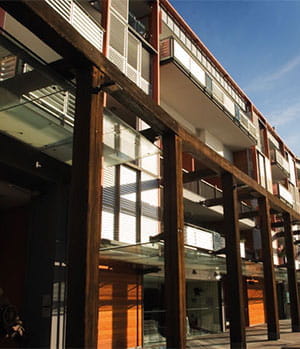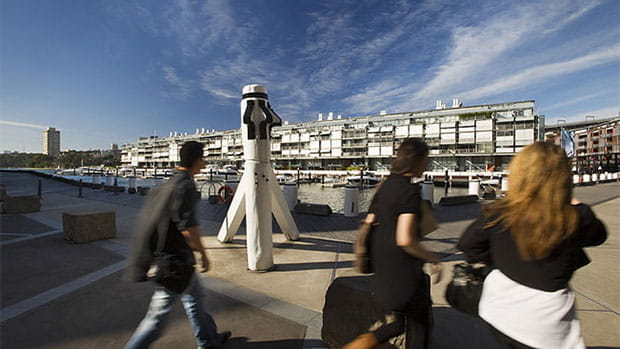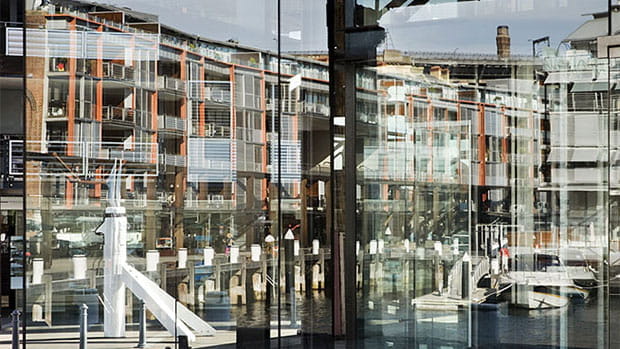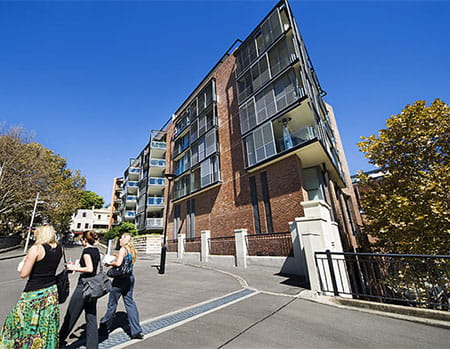walsh bay, nsw
A joint venture partnership between Mirvac and Transfield, Walsh Bay is one of the most significant urban renewal projects of a heritage precinct in Australia. Designed by Mirvac Design, in association with PTW, Tropman and Tropman Architects and Bates Smart, the redevelopment of Walsh Bay put Mirvac in the spotlight. Walsh Bay was one of Mirvac’s most high profile developments, with newspapers regularly reporting each scheme proposed. Although many of the heritage buildings at Walsh Bay had largely deteriorated, any changes to the site were monitored under the public gaze. Some even suggested leaving it the way it was. However, international architect Philippe Robert prophetically pointed out in his report to the New South Wales government that “the history of architecture is the history of change.”
Walsh Bay’s success was partially due to the site’s history being imaginatively incorporated into the built form. Pier 6/7, a purpose built residential pier, sensitively combines the historic fabric with modern architecture. “Walsh Bay was probably one of our most challenging projects. Many things were unforeseen,” says architect Anita Verma, Design Director, Mirvac Design. Verma clearly recalls one of several challenges when the remains of an undocumented 1820s cottage were discovered during excavation, now forming part of the heritage walk.
Collaboration between heritage architects and archaeologists has given Walsh Bay its unique character. The numerous architectural and heritage awards (national and international) received, reflect the importance of Walsh Bay, both to Mirvac and the community. Archaeological finds, along with remnants of 19th century technology, have been carefully interwoven in the new structures to create a memorable framework for contemporary living.
The Pottinger Street Terraces, the first of the residential developments to be completed at Walsh Bay, provided the initial benchmark (completed in 2001). Located above the main thoroughfare, Hickson Road, the 17 contemporary terrace style houses include basement car parking and individual lifts. “We respected the structure, while designing contemporary houses with exceptional levels of amenity to fit comfortably into the existing fabric,” says Verma, referring to the historic sandstone and the roof structure of the original Bond Stores located below.
While Walsh Bay includes homes and apartments, the development was not conceived as an exclusive enclave. The waterfront was opened to the public for the first time in a century. With a number of restaurants and cafes, the public can enjoy walking on boardwalks and follow historical paths through the development. Other developments in Walsh Bay are Towns Place, comprising residential apartments, an impressive public plaza and a five-level office building. The ‘heritage wall’, a sandstone wall at Towns Place, displays some of the artifacts discovered on site from as early as the 1800s. Parbury, another residential building, also combined the new with old, with the building’s sandstone base complimenting the contemporary façade. Pier 2/3 has also been conserved for cultural uses, with its original shore sheds readapted for commercial and retail spaces. The precinct has also become a focus for the arts, with a new state-of-the-art 857 seat drama theatre adding to the area’s long association with cultural groups such as the Bangarra Dance Theatre, and the Sydney Theatre Company.
For everyone connected with the development, the prestigious Royal Australian Institute of Architects Walter Burley Griffin Urban Design Award, along with 64 other awards since its inception, are a reminder of Walsh Bay’s success as an important precinct for the people of Sydney.






.jpg)